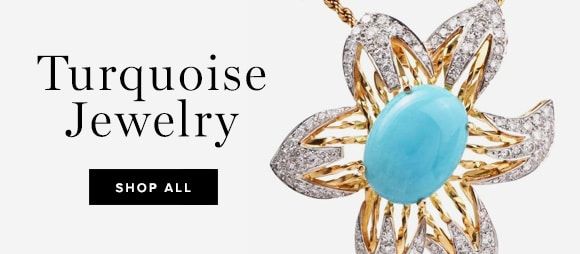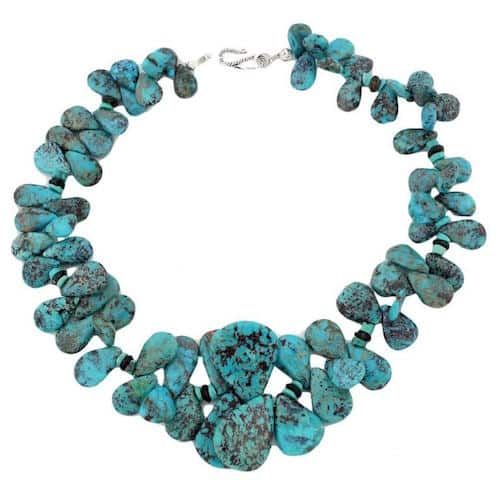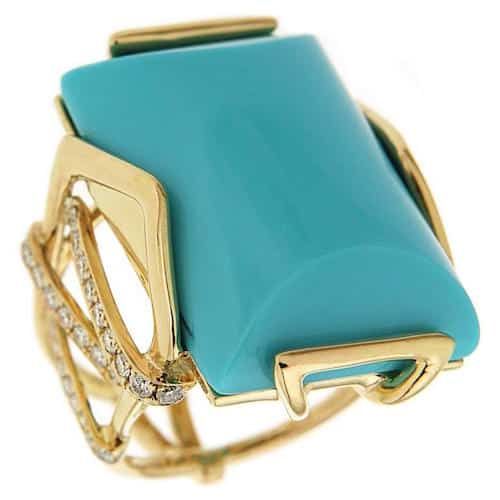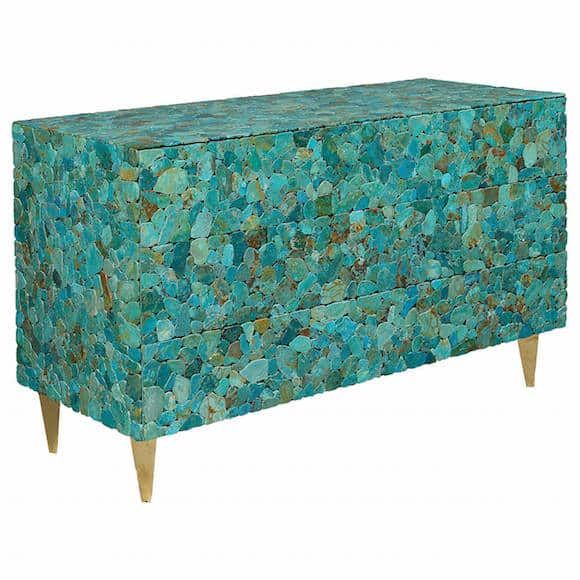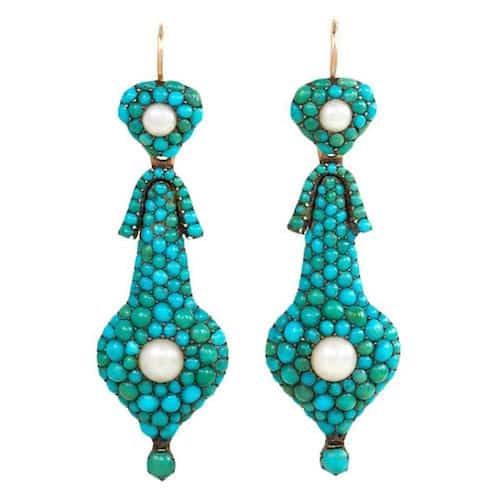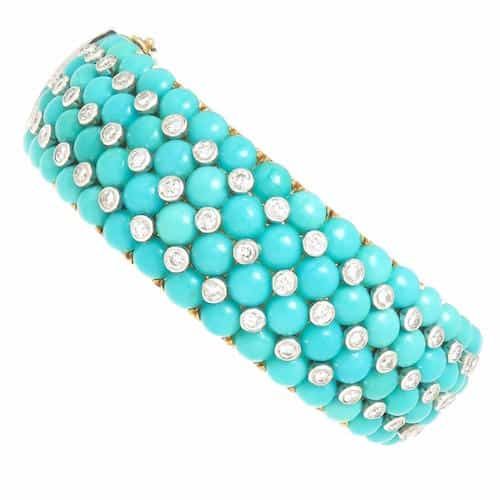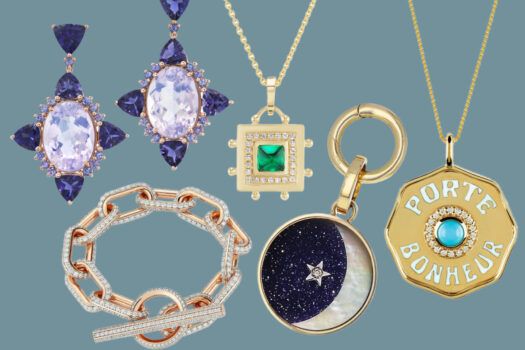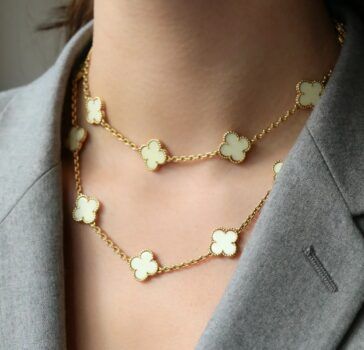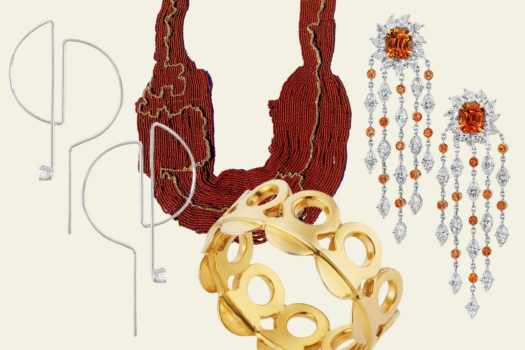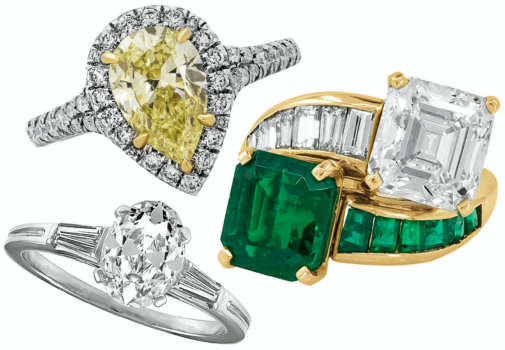The thought of turquoise jewelry often conjures up images of striking Navajo bracelets and necklaces worn with a denim shirt and cowboy boots. This all-American look has been celebrated by fashion designers like Ralph Lauren and Tommy Hilfiger on their runways and in ad campaigns. In the October 2016 issue of Vogue magazine, Tom Ford said he only wears turquoise jewelry at his Santa Fe ranch. So what is it about this gorgeous blue-green stone that makes us wish that we were born in December?
Chemical Composition
It’s not surprising that turquoise is abundant in New Mexico and Arizona because, according to the Gemological Institute of America (GIA), it needs to be in “dry and barren regions where acidic, copper-rich groundwater seeps downward and reacts with minerals that contain phosphorus and aluminum. The result of this sedimentary process is a porous, semi-translucent to opaque compound of hydrated copper and aluminum phosphate.” Chemically, turquoise is a hydrous phosphate of copper and aluminum, CuAl6(PO4)4(OH)8·5H2.
Turquoise is not found in a single crystal but is a combination of microcrystals. Its appearance, waxy and opaque, is attributed to its structure and composition. “It’s an aggregate of microscopic crystals that form a solid mass. If the crystals are packed closely together, the material is less porous, so it has a finer texture. Fine-textured turquoise has an attractive, waxy luster when it’s polished. Turquoise with a less-dense crystal structure has higher porosity and coarser texture, resulting in a dull luster when it’s polished,” notes the GIA. Since no one wants to set a dull piece of turquoise, porous turquoise is often treated to make the stone more attractive.
Porosity and texture also affects the stone’s ranking on the Moh’s Hardness Scale, where it only earns a 5 or 6 at most. On the plus side, because it is a softer stone, it a perfect for carving intricate sculptures. In fact, turquoise is considered to be the only semiprecious stone used to make decorative objects other than jewelry.
We often see turquoise shaped into flawless cabochon stones. However, it is not uncommon to see examples with spiderweb-like inclusions. These “veiny” lines are called matrix and are remnants of the host rock within the turquoise. Judging by the color of the lines, it is possible to deduce the host rock; for example, limonite creates dark brown markings in turquoise, while sandstone creates tan markings. Of course, stones that are free of any marks are most valued by dealers and their clients. But sometimes these lines are unavoidable and can often add character and beauty to an otherwise homogenous-looking stone.
Turquoise is a well-known color, so it might be surprising to learn that it can come in several shades other than the “robin’s egg blue.” The gemstone can range from blue-green to yellow-green. According to geologist Hobart King, “departure from a nice blue color is caused by small amounts of iron substituting for aluminum in the turquoise structure. The iron imparts a green tint to the turquoise in proportion to its abundance. Turquoise, especially the more porous varieties, can discolor with exposure to prolonged sunlight, heat, cosmetics, perspiration, and body oil.”
Historical Origins
An ancient gemstone, turquoise is said to bring the wearer good health and protection from evil spirits. The stone gets its name from the French “pierre tourques” or “Turkish stone” implying that it came to Europe from Turkey. However it is the Egyptians who first incorporated turquoise into their jewelry and archeologists found evidence of this during excavation of royal tombs over 6,000 years old. In fact, the legendary funeral mask of King Tut is inlaid with lapis, carnelian and turquoise. Most Egyptian Revival jewelry incorporates turquoise in the design.
In the United States, there have been discoveries of turquoise from 200 B.C. It is not just loose turquoise stones that have been found, but entire suites of jewelry from prehistoric times. In the late 19th-century, the Navajo Indians, who learned silversmithing from the Spanish, started to make beads out of turquoise and eventually combined it with silver around the 1880s. Initially this jewelry was for ceremonial purposes, but it became fashionable once the tourism in the Southwest picked up in the beginning of the 20th century.
Geographic Sources
The discovery of turquoise in most locations is due to large-scale copper mining and many sites have been depleted. Turquoise is one of the rare gemstones that is abundant in the United States, predominantly in the Southwest portion of the country. Arizona, California, Colorado, New Mexico and Nevada all have turquoise mines. Some of the oldest mines are in California and New Mexico were mined by pre-Columbian Native Americans. In particular, Cerillos, New Mexico is the home of the Cerrillos Turquoise Mining Museum and traces its history and activities to the year 900. In the beginning of the 20th century, this area was still considered to be the largest producer of turquoise, however this is no longer the case.
Presently, Arizona is thought to be the largest producer in the United States. In Globe, Arizona, which was started as a mining camp around 1875, one can find Sleeping Beauty turquoise in a mine of the same name. The Sleeping Beauty quarry is prized for its sky-blue matrix-free gemstones. In other parts of the world, turquoise mines are scattered around Egypt, Iran and China. It is still possible to find certain varieties of turquoise called Persian Blue, harking back to the times when the gem could be found in Persia (now Iran), where it has been mined for 2,000 years. In the Middle East, it is not uncommon to see turquoise used in architecture as a decorative element.
